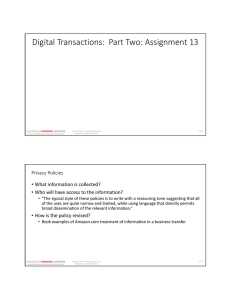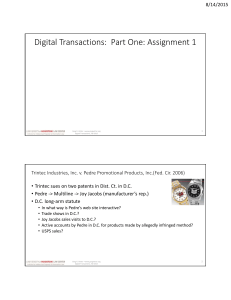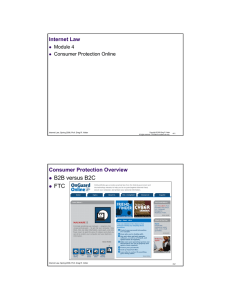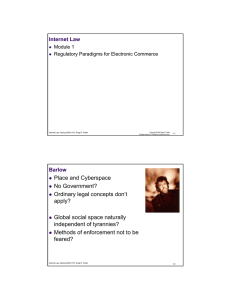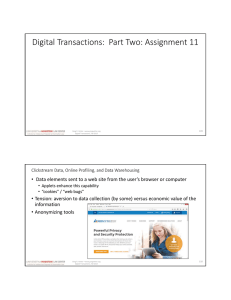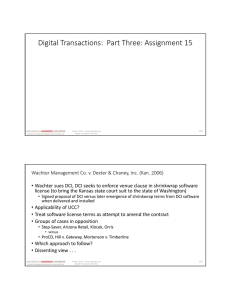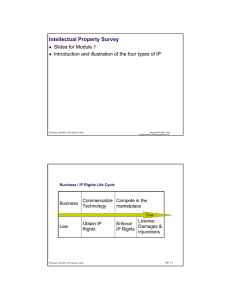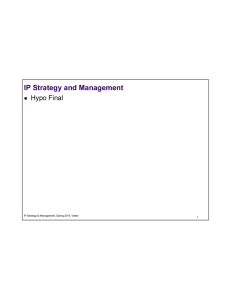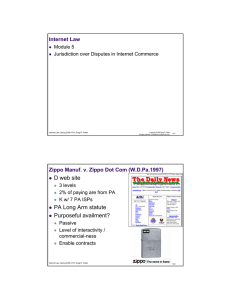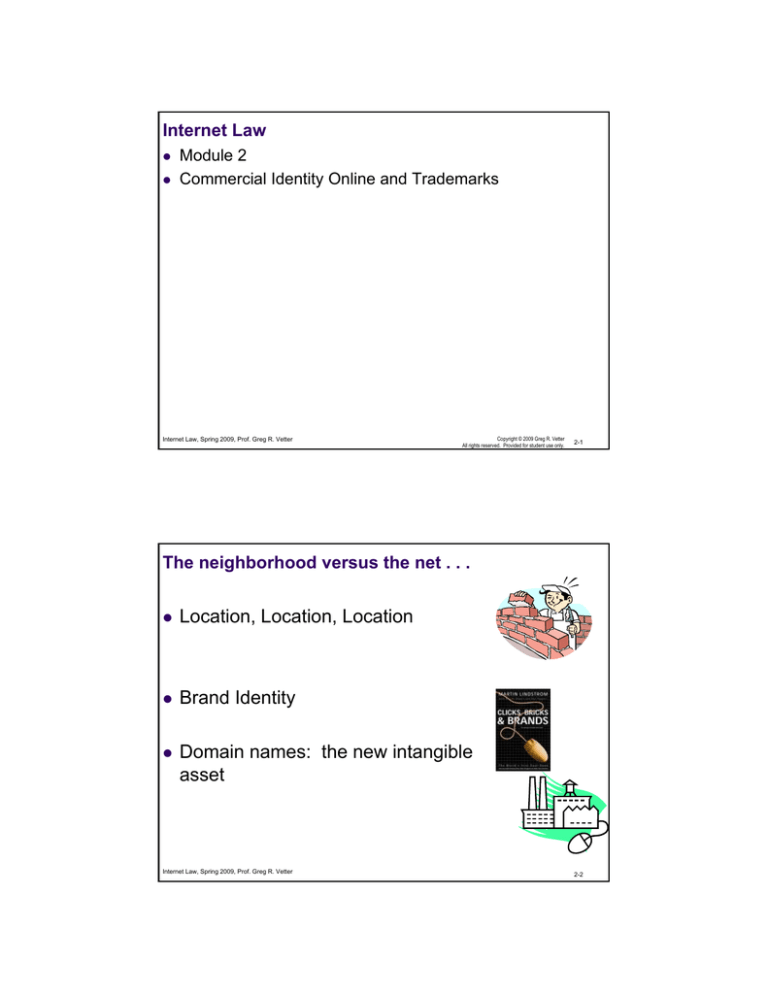
Internet Law
z
z
Module 2
Commercial Identity Online and Trademarks
Internet Law, Spring 2009, Prof. Greg R. Vetter
Copyright © 2009 Greg R. Vetter
All rights reserved. Provided for student use only.
2-1
The neighborhood versus the net . . .
z
Location, Location, Location
z
Brand Identity
z
Domain names: the new intangible
asset
Internet Law, Spring 2009, Prof. Greg R. Vetter
2-2
Trademark basics
z
z
z
z
Signal a common source, or at least affiliation
Words, phrases, logos . . .
Federal / state regimes
Use in commerce
z
z
z
Law of marks is based on use of the brand on goods
Exclusivity derives from that type of use in commerce
Must:
z
z
z
z
Registration not needed – but Federal registration is highly beneficial
Service marks
z
z
“Affix” the mark to goods
Move the marked goods in commerce
Used “in connection with” services to signal common source
Certification / Collective marks
Internet Law, Spring 2009, Prof. Greg R. Vetter
2-3
Trademark
Generic
Descriptive
Suggestive
“Brilliant” for
diamonds
“Brilliant” for
shoe polish
Arbitrary / Fanciful / Coined
aspirin
Internet Law, Spring 2009, Prof. Greg R. Vetter
“Brilliant” for
canned apple
sauce
2-4
Descriptive?
z
z
z
z
z
z
z
z
z
character
function
feature
quality
ingredient
nature
purpose
use
characteristics
z
dimensions, color,
odor. . .
Internet Law, Spring 2009, Prof. Greg R. Vetter
2-5
Genericness
Internet Law, Spring 2009, Prof. Greg R. Vetter
2-6
Generic
-ness
Internet Law, Spring 2009, Prof. Greg R. Vetter
2-7
Likelihood of Confusion HYPO
1.
2.
3.
4.
5.
6.
7.
8.
Internet Law, Spring 2009, Prof. Greg R. Vetter
strength of the mark
proximity of the
goods
similarity of the
marks
evidence of actual
confusion
marketing channels
used
type of goods and
the degree of care
likely to be exercised
by the purchaser
defendant's intent in
selecting the mark
likelihood of
expansion of the
product lines
2-8
Geographic Scope
z
z
z
Two c/l users of the
same TM
c/l rule – only protected
where products sold or
advertised
Exceptions:
z
z
z
Where reputation
established
Normal expansion of
business
Anywhere someone
intentionally trades on
the TM owner’s
goodwill
z
Earlier user has
superior rights in area
of overlap
z
User One
User Two
z
Internet Law, Spring 2009, Prof. Greg R. Vetter
2-9
Playboy v. Universal Tel-A-Talk (E.D.Pa.1998)
z
Senior user’s marks
z
z
PLAYBOY work mark
Rabbit Head Design symbol mark
z
z
Referred to as Playboy BUNNY
Trademark www.playboy.com
1.
2.
3.
z
Junior (alleged infringing) user’s use
z
Descriptive text on web page
z
z
z
z
“Playboy’s Private Collection”
URL use: “adult-sex.com/playboy/…”
Email name use; linking
LofC analysis
Internet Law, Spring 2009, Prof. Greg R. Vetter
4.
5.
6.
7.
8.
strength of the mark
proximity of the
goods
similarity of the
marks
evidence of actual
confusion
marketing channels
used
type of goods and
the degree of care
likely to be exercised
by the purchaser
defendant's intent in
selecting the mark
likelihood of
expansion of the
product lines
2-10
Albert v. Spencer (SDNY.1998)
1.
2.
z
Senior user
z
3.
AISLE SAY for magazine
published theatre reviews
4.
5.
6.
z
Junior user in good faith
z
z
z
www.aislesay.com
Similar content
7.
8.
strength of the mark
proximity of the
goods
similarity of the
marks
evidence of actual
confusion
marketing channels
used
type of goods and
the degree of care
likely to be exercised
by the purchaser
defendant's intent in
selecting the mark
likelihood of
expansion of the
product lines
LofC analysis
Internet Law, Spring 2009, Prof. Greg R. Vetter
2-11
Niton v. Radiation Monitoring Devices (D.Mass.1998)
z
z
Niton
RMD
z
z
Internet
searches for
Niton lead to
RMD web site
Why?
Internet Law, Spring 2009, Prof. Greg R. Vetter
<meta name="Description" content="Handheld
NITON XRF analyzers provide rapid, non-destructive
testing of metal alloys, electronic components,
environmental samples, art and artifacts, mining and
forensic samples. Customers have the choice of
miniature x-ray tube or radioisotope technology."
/><meta name="Keywords" content="NITON, XRF,
PMI, metal analysis, x-ray fluorescence, weee/RoHS,
Lead Paint Testing, Portable x-ray equipment,
portable XRF, XRF analysis, RoHS testing, RoHS
screening, xray fluorescence, XRF analyzer, portable
XRF analyzer, x-ray fluorescence analyzer, alloy
analysis, alloy testing, alloy identification, positive
material identification, metals analysis, scrap metal
recycling, ed XRF, scrap sorting, NITON Analyzer,
lead paint analysis, x-ray fluorescence instrument,
soil analysis, lead paint analyzer, RoHS directive" />
NITON XLp 300
<meta name="description" content="RMD - Radiation
Monitoring Devices, Inc - in Watertown, MA.
University quality research; commercial grade
products">
<meta name="keywords" content="RMD rmd
radiation monitoring devices watertown MA
massachusetts research technology thinktanks">
2-12
Types of confusion
z
Confusion as to the products
z
z
Confusion as to source
z
z
z
Confusion leading to purchase of infringer’s product when trademark (“TM”)
owner sells the same product
Infringer uses TM owner’s mark on products the TM owner does not sell at all
Two possible types of harm: (i) potentially inferior quality of infringer’s
products; (ii) if TM owner expands into product area where infringer sells, very
high chance of likelihood of confusion
Confusion as to sponsorship
z
For example, United States Olympic
Committee label on soup
z
Initial interest confusion
z
Post-sale confusion
z
Reverse Confusion
z
z
z
z
Confusion that is dispelled before purchase occurs
Soup
Confusion after the sale of a product
A large company adopts the mark of a smaller TM owner
Risk is not junior user trading on goodwill of senior, but that the public comes
to associate the mark not with its true owner, but with the infringing junior user
who may have spent a lot of money to advertise it
Internet Law, Spring 2009, Prof. Greg R. Vetter
2-13
Brookfield v. West Coast (9th.1998)
Initial Interest Confusion
Internet Law, Spring 2009, Prof. Greg R. Vetter
2-14
Brookfield v. West Coast (9th.1998)
1.
2.
3.
4.
5.
6.
7.
8.
“The Movie
Buff’s
Movie
Store”
strength of the mark
proximity of the
goods
similarity of the
marks
evidence of actual
confusion
marketing channels
used
type of goods and
the degree of care
likely to be exercised
by the purchaser
defendant's intent in
selecting the mark
likelihood of
expansion of the
product lines
Court holds that: moviebuff.com infringes the
Brookfield mark MOVIEBUFF
z
Internet Law, Spring 2009, Prof. Greg R. Vetter
2-15
Brookfield v. West Coast (9th.1998)
z
z
Second issue: can West Coast use, in other domain
names (not moviebuff.com), the term Moviebuff in
metatags?
No direct confusion
z
z
z
Search engines show both sites
Domain names are different
Initial interest confusion
z
Preliminary injunctive relief is appropriate in order to
eliminate West Coast’s use of metatags confusingly similar
to Moviebuff
Internet Law, Spring 2009, Prof. Greg R. Vetter
2-16
Playboy v. Netscape (9th.2004)
z
Excite/Netscape
z
Require adult oriented companies
using keyword search banner ads
to use a 400+ term list containing
z
z
z
z
playboy
playmate
LofC factors favor a showing that
there is initial interest confusion
(IIC) when banner ads not labeled
Concurrence concern w/ Brookfield
z
z
If banner ads are labeled, no IIC
Mere distraction with another choice in
the list
1.
2.
3.
4.
5.
6.
7.
8.
strength of the mark
proximity of the
goods
similarity of the
marks
evidence of actual
confusion
marketing channels
used
type of goods and
the degree of care
likely to be exercised
by the purchaser
defendant's intent in
selecting the mark
likelihood of
expansion of the
product lines
Internet Law, Spring 2009, Prof. Greg R. Vetter
2-17
Gov't Employee Ins. Corp. v. Google (E.D.Va.2004)
z
z
GEICO as mark holder seeks to stop
Google’s “practice of selling advertising
linked to [GEICO’s] trademarks”
Sufficient allegations that it is “trademark
use” when searching for GEICO on Google
brings up sponsored links with the GEICO
mark in the text or heading of the ad
Portion of
the Google
AdWords
FAQ,
Trademark
section, from
1/20/2008
Internet Law, Spring 2009, Prof. Greg R. Vetter
2-18
Bihari v. Gross (SDNY.2000)
z
z
Disgruntled interor design client, Gross, registers
www.bihari.com and www.bihariinteriors.com
Later, into the dispute, after taking down these 2
sites, Gross registers 2 others; both using Bihari
strength of the mark
Interiors in metatags
proximity of the
1.
2.
3.
z
As a “TM.Use” – LofC analysis
4.
5.
6.
7.
8.
goods
similarity of the
marks
evidence of actual
confusion
marketing channels
used
type of goods and
the degree of care
likely to be exercised
by the purchaser
defendant's intent in
selecting the mark
likelihood of
expansion of the
product lines
Internet Law, Spring 2009, Prof. Greg R. Vetter
2-19
1-800 Contacts v. WhenU.Com (2nd.2005)
z
z
z
Dist. Ct. – preliminary injunction against WhenU
WhenU’s software, downloaded to a user PC, has a
directory of web addresses, search terms and
keywords
Pop up/under or panoramic ads upon user access to
1-800 site
z
Five complaints by 1-800 / two relied on by the district
court
z
Use in the “SaveNow” directory
Use by displaying the pop up/under and panoramic
windows
z
Three distinct elements: use / in commerce / LofC
z
Internet Law, Spring 2009, Prof. Greg R. Vetter
2-20
Dilution – possible types or theories of harm
“Tiffany” example (famous Other Example(s)
Type
mark for a jewelry store)
[example described in a
recent 7th circuit case]
Blurring
“Tiffany” for an upscale
Goldfish
restaurant
Dupont shoes, Buick
aspirin tablets, Schlitz
varnish, Kodak pianos,
Bulova gowns
Tarnishment “Tiffany” for a “restaurant” John Deere
that is actually a
“striptease joint”
Snuggles
Victoria’s Secret
Internet Law, Spring 2009, Prof. Greg R. Vetter
2-21
Dilution – § 43(c) – remedies for dilution of famous marks (Act of 2006)
(1) INJUNCTIVE RELIEF.—Subject to the principles of equity, the owner of a famous
mark that is distinctive, inherently or through acquired distinctiveness, shall be entitled to
an injunction against another person who, at any time after the owner’s mark has
become famous, commences use of a mark or trade name in commerce that is likely to
cause dilution by blurring or dilution by tarnishment of the famous mark, regardless of
the presence or absence of actual or likely confusion, of competition, or of actual
economic injury.
(2) DEFINITIONS.--(A) For purposes of paragraph (1), a mark is famous if it is widely
recognized by the general consuming public of the United States as a designation of
source of the goods or services of the mark’s owner. In determining whether a mark
possesses the requisite degree of recognition, the court may consider all relevant
factors, including the following:
(i) The duration, extent, and geographic reach of advertising and publicity of the
mark, whether advertised or publicized by the owner or third parties.
(ii) The amount, volume, and geographic extent of sales of goods or services offered
under the mark.
(iii) The extent of actual recognition of the mark.
(iv) Whether the mark was registered . . . on the principal register.
Internet Law, Spring 2009, Prof. Greg R. Vetter
2-22
Dilution (Trademark Dilution Revision Act of 2006)
(B) For purposes of paragraph (1), ‘dilution by blurring’ is association arising from the similarity between a mark
or trade name and a famous mark that impairs the distinctiveness of the famous mark. In determining whether a
mark or trade name is likely to cause dilution by blurring, the court may consider all relevant factors, including the
following:
(i) The degree of similarity between the mark or trade name and the famous mark.
(ii) The degree of inherent or acquired distinctiveness of the famous mark.
(iii) The extent to which the owner of the famous mark is engaging in substantially exclusive use of the mark.
(iv) The degree of recognition of the famous mark.
(v) Whether the user of the mark or trade name intended to create an association with the famous mark.
(vi) Any actual association between the mark or trade name and the famous mark.
(C) For purposes of paragraph (1), ‘dilution by tarnishment’ is association arising from the similarity between a
mark or trade name and a famous mark that harms the reputation of the famous mark.
(3) EXCLUSIONS.--The following shall not be actionable as dilution by blurring or dilution by tarnishment under
this subsection:
(A) Any fair use, including a nominative or descriptive fair use, or facilitation of such fair use, of a famous mark
by another person other than as a designation of source for the person's own goods or services, including use in
connection with-(i) advertising or promotion that permits consumers to compare goods or services; or
(ii) identifying and parodying, criticizing, or commenting upon the famous mark owner or the goods or services
of the famous mark owner.
(B) All forms of news reporting and news commentary.
(C) Any noncommercial use of a mark.
Internet Law, Spring 2009, Prof. Greg R. Vetter
2-23
Brookfield v. West Coast (9th.1998)
Fair Use
z
Truthful use to identify a competitor’s goods
z
z
z
MovieBuff isn’t used as a descriptive term in West
Coast’s metatags
z
z
Rightful copying
Comparative advertising
movie buff, or Movie Buff is different, due to the space
Hypothetical allowed use: “Why pay for MovieBuff
when you can get the same thing here for free?”
Internet Law, Spring 2009, Prof. Greg R. Vetter
2-24
Bihari v. Gross (SDNY.2000)
Fair Use
z
z
z
z
Fair use applies to the online context
Not necessary for plaintiff’s mark to be
characterized as “descriptive”
Gross used the terms not as a mark, but to identify
Bihari
A different rule forecloses (chills) discource and
comment
Internet Law, Spring 2009, Prof. Greg R. Vetter
2-25
Playboy v. Welles (9th.2002)
z
z
z
z
Reverses S/J of LofC and Dilution
Traditional fair use is for describing
Nominative fair use is for naming when there is no good
alternative
3-factor test instead of LofC analysis
z
z
z
z
Welles’ uses of PEI marks
z
z
z
z
No descriptive substitute
Use no more of mark than necessary
No suggestion of sponsorship or endorsement, even if commercial
use
Headlines and banner ads (nominative)
Metatags (nominative, sufficiently sparse use)
Wallpaper/Watermarks (“PMOY ’81” pattern not nominative)
No Dilution for headlines and metatags, remand for PMOY
Internet Law, Spring 2009, Prof. Greg R. Vetter
2-26
Planned Parenthood v. Bucci (SDNY.1997)
z
z
z
z
z
z
Planned Parenthood mark: strong, “incontestable”
PP web site is www.ppfa.org
Bucci established www.plannedparenthood.com
Initial greeting text declares it as PP’s home page
First amendment protects use of a mark when
used in a communicative message (or a title), not
when used to identify the source a product
No artistic implications of plannedparenthood.com
as a title
Internet Law, Spring 2009, Prof. Greg R. Vetter
2-27
Bally v. Faber (C.D.Cal.1998)
z
Complaint site: www.compupix.com/ballysucks
z
Different from
z Enjoy Cocaine
z Mutant of Omaha
Faber’s speech is protected by First
Amendment
Thus protecting his use of the mark
z
z
Internet Law, Spring 2009, Prof. Greg R. Vetter
2-28
Name.Space v. Network Solutions (2nd.2000)
z
Alternative gTLD system
z
Some sufficiently lengthy to perhaps be expressive
z
z
z
z
z
.forpresident
.microsoft.free.zone
Name.Space alleges NSI’s refusal to include new
gTLDs into the zone file of the root servers is a 1st
Amendment problem
Appellate court rejects analogy below of domain
names to telephone numbers and alpha addresses
Also, their functional nature also doesn’t
automatically exclude them from 1st Amendment
protection
Internet Law, Spring 2009, Prof. Greg R. Vetter
2-29
Taubman Co. v. Webfeats (6th.2003)
z
z
z
Taubman mark: The Shops at Willow Bend
Misleading commercial speech isn’t protected by
the 1st Amendment
Use in www.taubmansucks.com is purely an
exhibition of Free Speech
z
Lanham act is not invoked
Internet Law, Spring 2009, Prof. Greg R. Vetter
2-30

